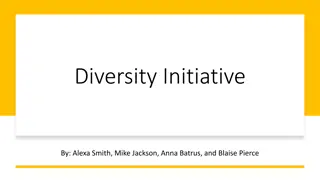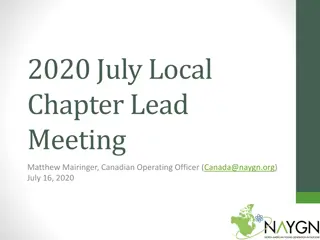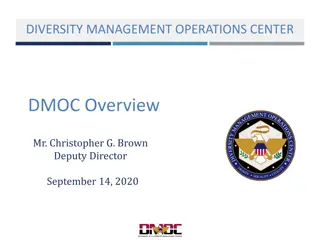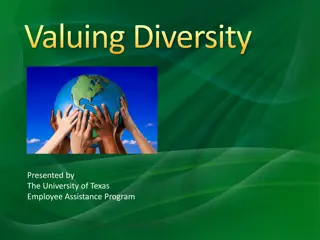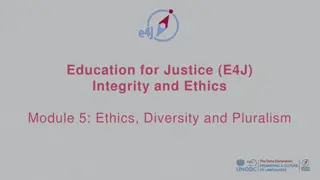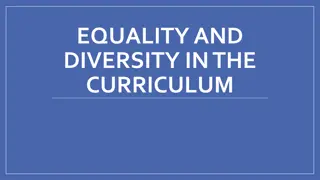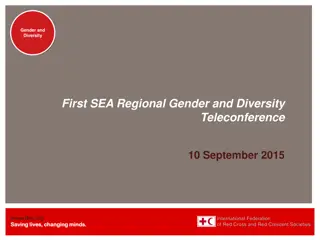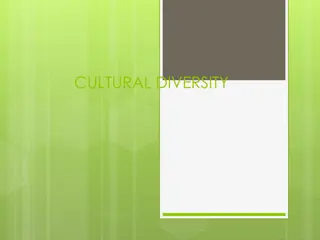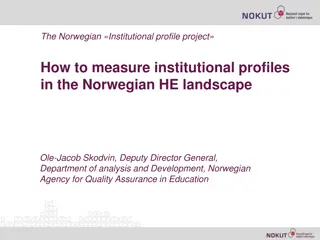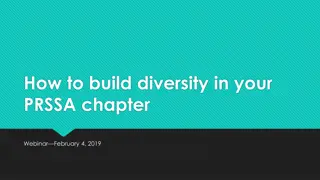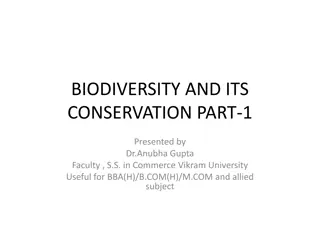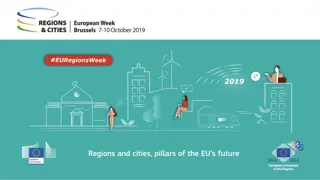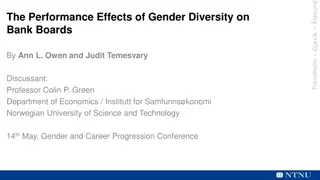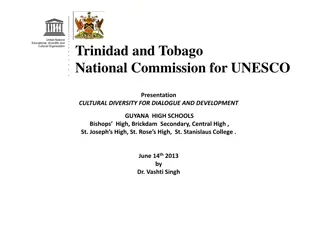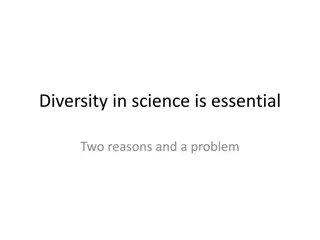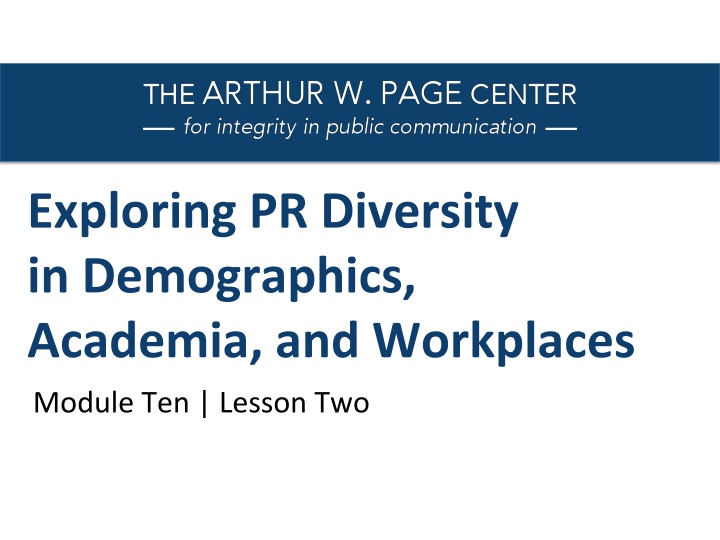
Diversity and Inclusion in Public Relations
Explore the importance of diversity and inclusion in public relations, focusing on demographics, academia, and workplaces. Learn about the current state of race, ethnicity, and gender disparities in the industry, as well as strategies to recruit more diverse talent, promote women to leadership roles, and address salary discrepancies. Essential diversity terms and key knowledge areas are also highlighted.
Download Presentation

Please find below an Image/Link to download the presentation.
The content on the website is provided AS IS for your information and personal use only. It may not be sold, licensed, or shared on other websites without obtaining consent from the author. If you encounter any issues during the download, it is possible that the publisher has removed the file from their server.
You are allowed to download the files provided on this website for personal or commercial use, subject to the condition that they are used lawfully. All files are the property of their respective owners.
The content on the website is provided AS IS for your information and personal use only. It may not be sold, licensed, or shared on other websites without obtaining consent from the author.
E N D
Presentation Transcript
Exploring PR Diversity in Demographics, Academia, and Workplaces Module Ten | Lesson Two
Lesson Two | Introduction Lesson Overview Understanding diversity demographics Educating about D&I/culture Recruiting diverse PR students Retaining diverse PR practitioners Reaching diverse audiences Making the business case for diversity
Race and ethnicity demographics The U.S. will be a majority-minority by 2044. By 2060, people of two or more races are expected to be the fastest-growing population, followed by Asians and Hispanics. Compared to U.S. demographics, people of color are under-represented in the public relations profession.
Gender and salary demographics Women, who are 50.8% of the U.S. population, make up 70% of the public relations workforce but only 30% of executives. The gender balancing in improving in some C-suite environments. Men still earn more than women in PR, but pay is increasing.
Lesson Two | Introduction Discussion Question One What can the public relations profession do to recruit more people of color, promote more women to managerial/executive roles, and increase the salaries of women?
Lesson Two | Introduction Educating about D&I/Culture After ethics, diversity and inclusion are the second most important knowledge areas for entry-level PR practitioners. Cultural perspective ranks third out of 12 essential knowledge areas. Source: Commission on Public Relations Education
Lesson Two | Introduction Key diversity terms Culture - includes behaviors, thinking, beliefs, values, communications styles and language expressions Stereotypes - judgments about an individual based on that person s membership in a particular classification Prejudice - irrational dislike, suspicion or hatred of a certain demographic group Ethnocentrism - negative judgment of other cultures based on the belief that a particular cultural perspective is better than others Source: Commission on Public Relations Education
Lesson Two | Introduction Recruiting diverse PR students educate community and family members about what PR is professional networking and mentoring opportunities student interaction with classmates from underrepresented backgrounds discussing PR diversity issues in class
Lesson Two | Introduction Discussion Question Two What made you decide to major in public relations? What else can be done to recruit PR majors from diverse backgrounds?
Lesson Two | Introduction Retaining diverse PR practitioners in the U.S. Three factors that could hurt retention efforts 1. Pigeon-holing 2. Recruitment to fill minority quota 3. First and only
Lesson Two | Introduction Retaining diverse PR practitioners in the UK Four factors that could hurt retention efforts 1. Racism and microaggressions 2. Inflexible and noninclusive culture 3. Lack of equal opportunities and progression 4. Unconscious bias
Lesson Two | Introduction Reaching diverse audiences Four ideas from past research: 1. Understanding the diverse needs of individuals 2. understanding the power of telling individual stories 3. Using new tools and technologies to reach the under-represented and marginalized 4. Reaching and mobilizing diverse publics while giving them priority Source: Mundy (2016)
Lesson Two | Introduction Making the business case for diversity 1. Helps stakeholders such as employees, shareholders, and customers. 2. Increases profitability 3. Enhances economic profit margins 4. Connects values to actions
Lesson Two | Introduction References Brown, K. A., White, C., & Waymer, D. (2011). African-American students perceptions of public relations education and practice: Implications for minority recruitment. Public Relations Review, 37(5), 522-529. https://doi.org/10.1016/j.pubrev.2011.09.017 Brown, K. A., Waymer, D., & Zhou, Z. (2019). Racial and Gender-Based Differences in the Collegiate Development of Public Relations Majors: Implications for Underrepresented Recruitment and Retention. AEJMC Network Networking Home for Divisions and Interest Groups. https://aejmc.us/jpre/wp- content/uploads/sites/25/2019/01/JPRE-5.1-January-2019-BROWN-WAYMER-ZHOU.pdf Chitkara, A. (2019). World in 2020:The Age of Organizational Transparency & Accountability Doing What We Say Matters. World in 2020 Project. Worldin2020.com Colby, S. L., & Ortman, J. M. (2015, March). Projections of the Size and Composition of the U.S. Population: 2014 to 2060. Census.gov. https://www.census.gov/content/dam/Census/library/publications/2015/demo/p25-1143.pdf Commission on Public Relations Education. (2017). FAST FORWARD Foundations + Future State. Educators + Practitioners. http://www.commissionpred.org/commission-reports/fast-forward-foundations-future-state-educators-practitioners/ Hunt, V., Yee, L., Prince, S., & Dixon-Fyle, S. (2018, January 18). Delivering through diversity. McKinsey & Company. https://www.mckinsey.com/business- functions/organization/our-insights/delivering-through-diversity Mundy, D. E. (2016, August). Bridging the divide: A multidisciplinary analysis of diversity research and the implications for public relations. Institute for Public Relations. https://instituteforpr.org/bridging-divide-key-findings-best-practices-call-action-diversity-focused-public-relations-organizational- management-research/ Race in PR: BAME lived experiences in the UK PR industry. (2020). Chartered Institute of Public Relations. https://newsroom.cipr.co.uk/unequal- opportunities-non-inclusive-cultures-and-racist-experiences-cipr-publishes-new-report-into-lived-experiences-of-bame-practitioners-in-pr/ PR Week. (2018, February 2). What it's like to be black in PR [Video]. YouTube. https://www.youtube.com/watch?v=gsd4Y47tsgM

